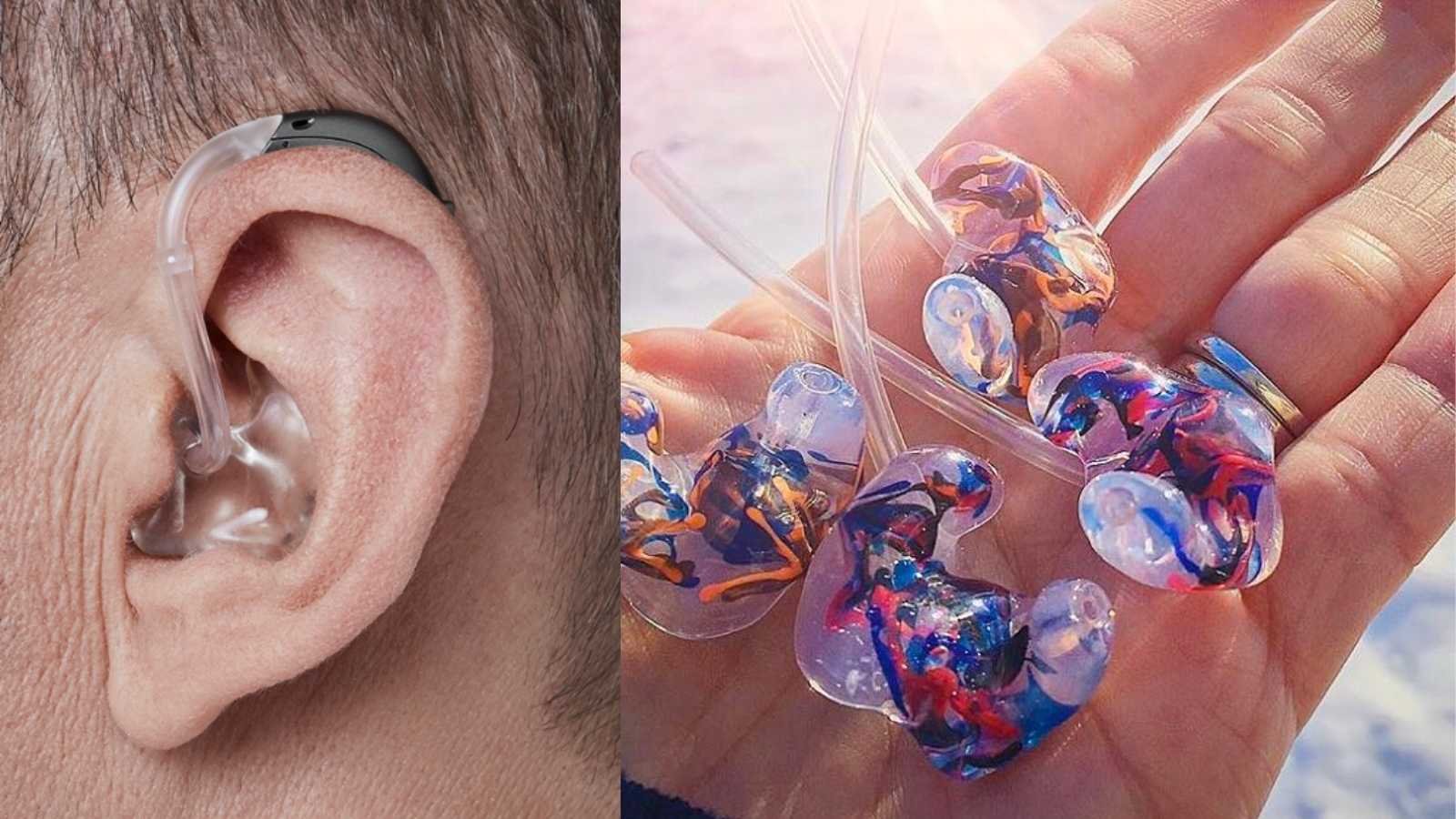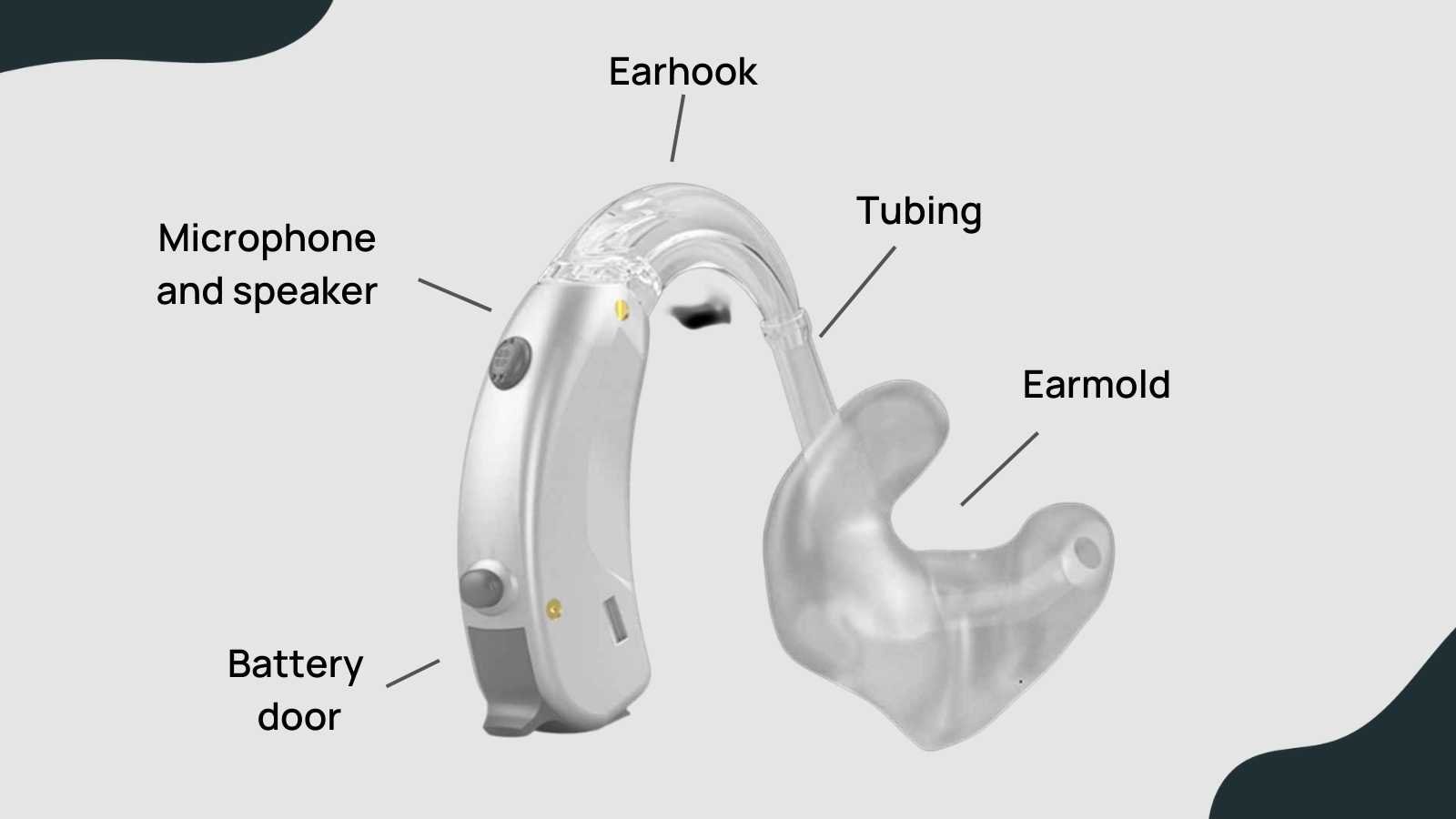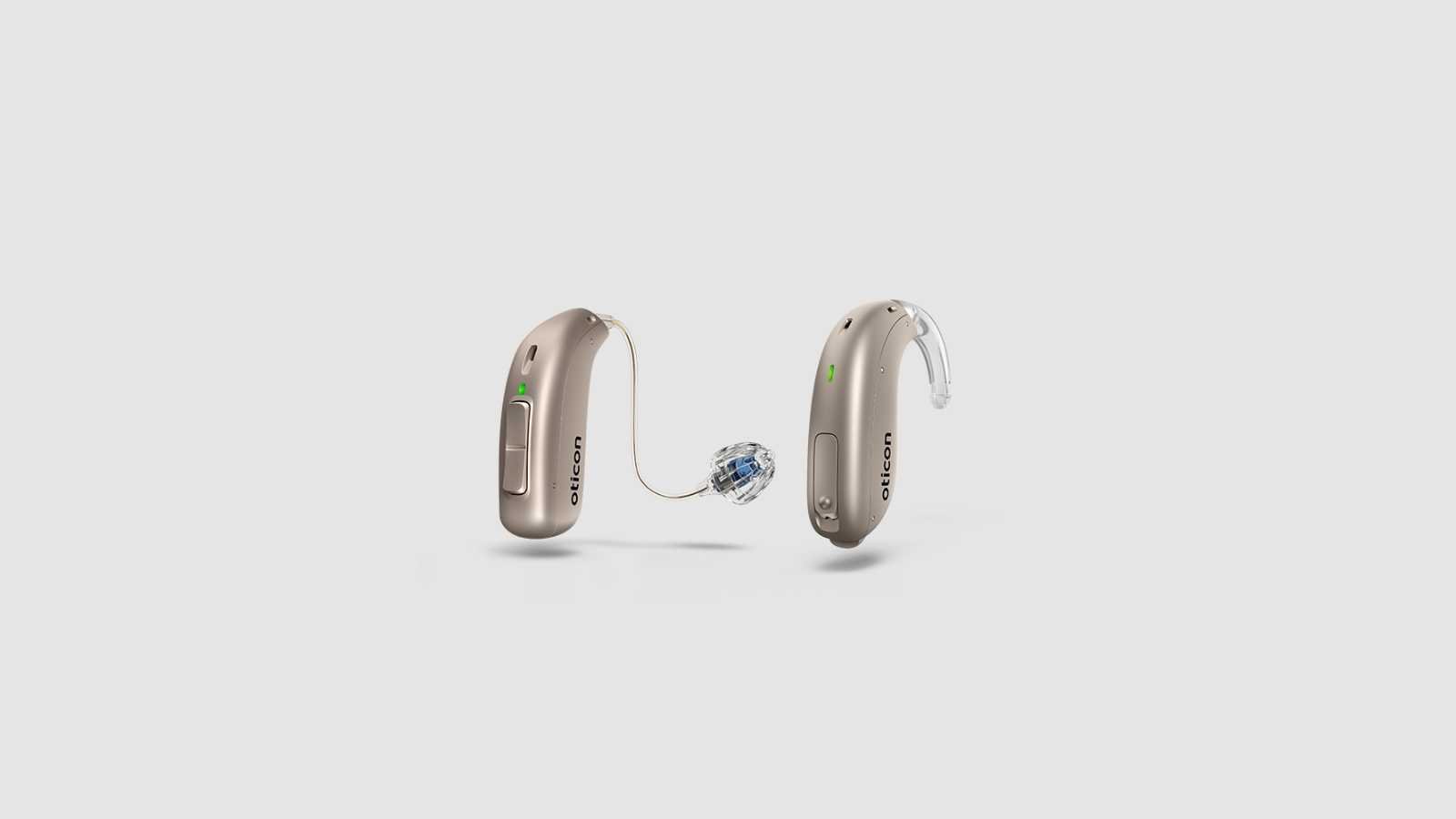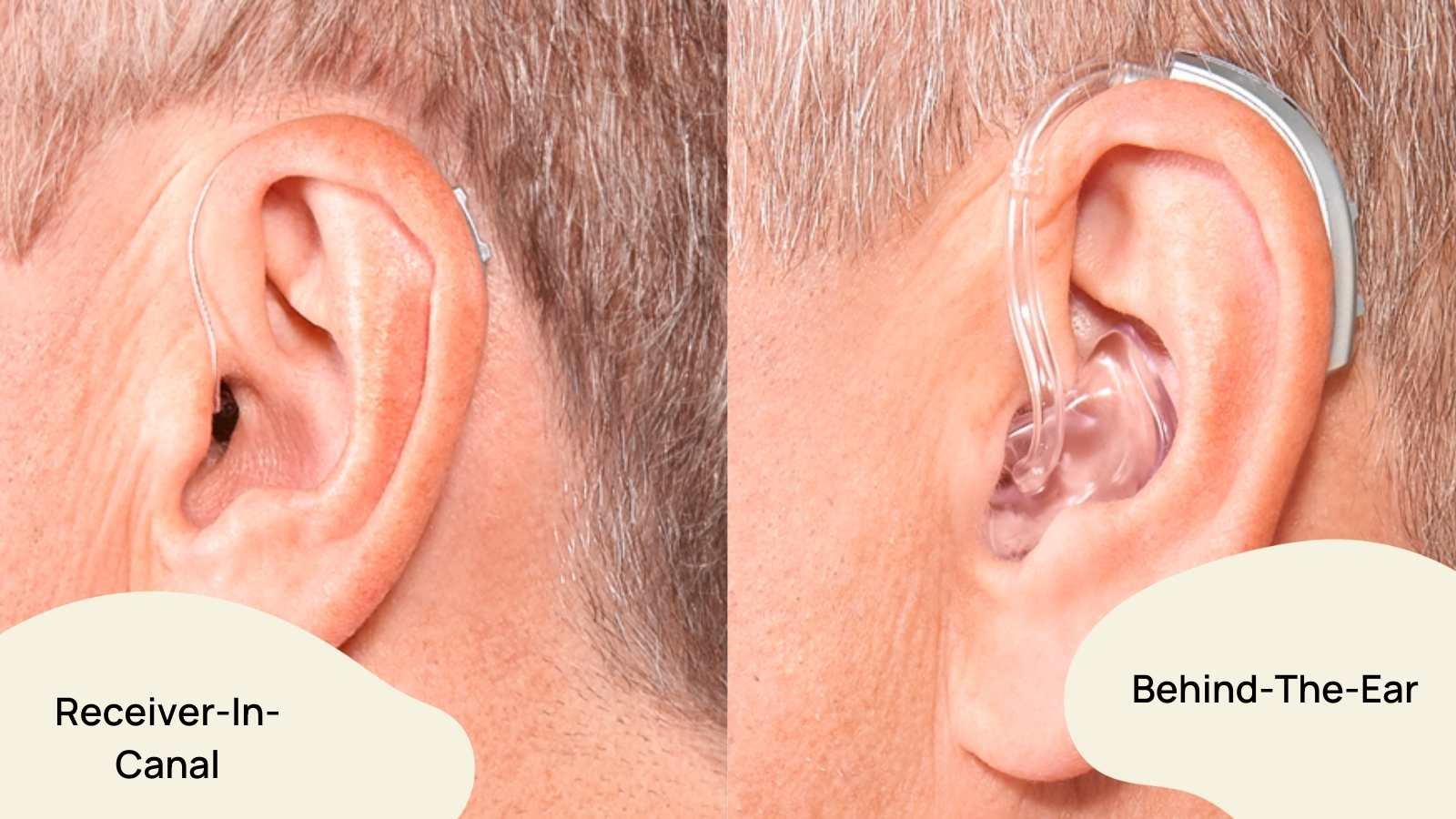Key Takeaways:
- BTE hearing aids are most commonly worn by those with severe to profound hearing loss.
- A BTE requires an earmold and tubing, or in some cases a slim tube and dome tip.
- While BTEs can be more visible than the more popular RIC style, BTEs can't be beat when it comes to powerful amplification.

Behind-the-ear hearing aids, also known as BTEs, are a popular type of hearing aid for various reasons.
They're appropriate for people of all ages and offer many features and benefits. In this guide, we'll delve into the nitty-gritty of BTEs—what they are, how they work, who can wear them, and how they differ from RIC hearing aids.
By the end, you'll have a much better understanding of this hearing aid style and how it can help you or your loved one hear better.
What is a behind-the-ear(BTE)hearing aid?

A BTE hearing aid is a hearing aid that fits behind the ear with a tube that sends sound into the ear canal.
It consists of three main parts:
- The earmold (custom-made to fit the contours of your ear),
- The tubing (runs between the hearing aid and the earmold)
- The body of the hearing aid (that sits behind the ear)
BTEs are often recommended for people with severe or profound hearing loss because they can accommodate high-powered amplification.
Additionally, children with hearing loss tend to wear BTEs due to the ease of fit as they grow.
BTEs are slightly larger than receiver-in-canal (RIC) hearing aids, and the device's larger size allows them to provide more volume.
Who can wear a BTE?

These hearing aids are an excellent option for those with more severe hearing loss.
However, even if you don't have severe hearing loss, you may still opt for a BTE because they offer great features and benefits that other types of hearing aids may not.
For example, BTEs are large enough to house Bluetooth connectivity, telecoil features, and Smartphone app connectivity (most RIC hearing aids also support these features). Depending on the size, smaller custom hearing aids do not have these features available.
BTEs can be worn by people of all ages, including children as young as 1 or 2 years old. They're often the first hearing aid prescribed to infants and young children with hearing loss. This is because BTEs can be fit with an earmold that can be replaced as they grow.
Children may require additional accessories or tips to help hearing aids stay in place. For example, these headbands or pilot caps come in fun colors and help to keep the hearing aids comfortably in place.
If you're unsure whether a BTE is suitable for you or your child, consult an audiologist to discuss your options.
How does a BTE work?

BTEs work by picking up sound in your environment, amplifying it and piping it to your ear through the tubing to the earmold.
This type of hearing aid is capable of high power output and is beneficial for people with more severe hearing loss because they can accommodate high-powered amplification.
BTEs and hearing aid feedback (squealing sounds).
Recent hearing aid technology has come a long way in feedback suppression (squealing sometimes heard from a hearing aid).
Today's hearing aids are much "smarter" and can reduce the chances of any feedback from the hearing aids, even at high outputs typical from BTE hearing aids.
If you notice any feedback, it could be due to how the earmold fits in the ear. Talk with your audiologist about your BTE feedback concerns.
Feedback can be reduced through programming changes or by re-making the earmold for a tighter fit.
BTE hearing aid parts.

BTE hearing aids consist of several parts:
- An earmold
- Tubing
- An earhook
- A battery compartment
We'll go into more detail about each part below.
Let's start with the earmold.
An earmold is custom-made to fit snugly in your ear canal. Most earmolds are made from either silicone or acrylic material.
An audiologists creates an earmold using a special silicone gel or digital scanner to capture the exact shape of your ear canal.
The primary purpose of the earmold is to direct sound from the hearing aid into your ear canal without sound leaking out.
Earmolds come in various colors, so you can choose one that best matches your skin tone or express your personality. You can choose everything from clear to bright pink!
Next is the earhook.
The earmold is attached to tubing that connects to the earhook that sits just at the top portion of the pinna (top of the ear).
This little piece is the 'bridge' that funnels the sound from the speaker in the hearing aid to the tubing and then into the ear canal.
Most earhooks are made of acrylic or other more rigid material. Still, some earhooks also come in different materials, such as titanium, that allow a little extra sound boost for those with more profound hearing loss.
The earhook attaches to the hearing aid either by twisting on or snapping on.
BTE hearing aid tubing.
Tubing connects the earmold to the earhook. It's made from either clear plastic or rubber, and its primary purpose is to transmit sound from the hearing aid to the earmold.
Depending on your earmold type, tubing may be attached to the earmold with glue or a particular type of tubing (called TRS) with a ring that locks into the earmold.
BTE microphone and speaker placement.
When the hearing aid is placed on the ear, the microphone ports will be located just at the top of the hearing aid.
The microphones collect sound from the environment, sending them to the processor and amplifier to create the optimal volume for the user's level of hearing loss. The speaker then creates a sound that moves through the hearing aid and into the ear.
Battery compartment.
If you use disposable batteries, it will be important to open the battery compartment at night.
There are two reasons for this routine:
1) Opening the battery door turns off the hearing aid and stops the battery from draining.
2) Opening the battery door allows moisture to escape. It's important to keep moisture at bay to reduce the chances of corrosion build-up in the battery compartment. For those with rechargeable hearing aids, you'll place the hearing aid in the charger at night.
How BTEs are different from RICs

RICs (Receiver-in-the-Canal) are visually similar to BTEs. Both styles fit behind the ear and send sound through a tube or wire into the ear canal.
However, there are several key differences between these two types of hearing aids.
Perhaps the most significant difference: a RIC houses the speaker directly inside the ear canal, while the speaker in a BTE is located within the body of the hearing aid. Why is it important to note this difference?
A receiver-in-canal hearing aid has less power because the speaker is smaller.

RIC hearing aids can also be more susceptible to wax or debris. With a BTE, the speaker is housed further away from the ear, which allows for more size, power, and safety from earwax.
Either BTE or RIC hearing aids can be a good choice, depending on the user's needs and hearing loss.
However, those with more wax build-up, drainage, or chronic ear infections should consider this aspect of a RIC hearing aid before making their decision.
Visual differences between BTE and RIC hearing aids.

Another key difference is that the receiver wire on a RIC is much thinner than the tubing on a BTE, which some people find more aesthetically pleasing.
BTE hearing aids can support higher amplification levels than RIC hearing aids and are common among those with severe or profound hearing loss.
How to clean a BTE
It is important to keep your BTE clean in order to maintain optimal sound quality and prevent ear infections.
To clean your BTE hearing aids, you will need:
- A brush for wiping away debris
- Non-alcohol-based wipes or tissues
- Pipe cleaner or dental floss
- (optional) A hearing aid dryer
Cleaning process.
#1. When taking the hearing aids out at night, remove any debris from the earmold using a soft cloth or non-alcohol-based wipe.
#2. Use a brush to clear the microphone ports of wax.
#3. Use a pipe cleaner, dental floss, or a small filament wire to clean the earmold portion of the earing aid.
#4. Those who live in humid climates may consider a hearing aid dryer, such as a Zephyr, to reduce moisture buildup in the device. Unfortunately, electronics and moisture don't mix well!
Conclusion
BTE hearing aids are popular for a reason—they're effective, durable, and comfortable.
If you're considering a hearing aid and need advice, ask an audiologist whether a BTE is the right option for you.






